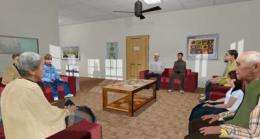Human unconscious is transferred to virtual characters

Virtual characters can behave according to actions carried out unconsciously by humans. Researchers at the University of Barcelona have created a system which measures human physiological parameters, such as respiration or heart rate, and introduces them into computer designed characters in real time.
"The ultimate aim is to develop a method which allows humans to unconsciously relate with some parts of the virtual environment more intensely than with others, and that they are encouraged only by their own physiological responses to the virtual reality shown", Christoph Groenegress, co-author of the work and researcher at the University of Barcelona explains to SINC.
The system, the details of which were recently published in the journal The Visual Computer, uses sensors and wireless devices to measure three physiological parameters in real time: heart rate, respiration, and the galvanic (electric) skin response. Immediately, the data is processed with a software programme that is used to control the behaviour of a virtual character who is sitting in a waiting room.
The heart rate is reflected in the movement of the character's feet; respiration in the rising of their chest (exaggerated movements so that it can be noticed); and the galvanic skin response in the more or less reddish colour of the face.
The researchers conducted an experiment to see if the people whose physiological parameters were recorded had any preference as regards the virtual actor who was to use them, without them knowing in advance. But the result was negative, "probably because other factors also influence the choice such as the character's appearance or their situation in the scene". The team is now studying how to solve this problem.
To tell stories and in rehabilitation
The scientists point out that the unconscious processes can be a useful tool for telling stories -in a video-game, for example- or for arousing interest in participants when carrying out a sequence of tasks, such as patients undergoing rehabilitation.
"We maintain that the linking of subjective corporal states to a virtual reality can improve the sensation of realism that a person has of this reality and, eventually, create a stronger link between humans and this virtual reality", Groenegress concludes.
More information: Christoph Groenegress, Bernhard Spanlang y Mel Slater. "The physiological mirror - a system for unconscious control of a virtual environment through physiological activity". The Visual Computer 26 (6-8): 649, 2010. DOI: 10.1007/s00371-010-0471-9
Provided by FECYT - Spanish Foundation for Science and Technology


















